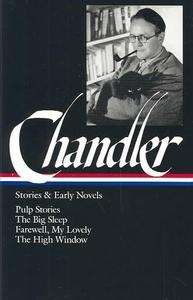Stories and Early Novels

Resumen del libro
In his first novel, The Big Sleep (1939), the classic private eye finds his full-fledged form as Philip Marlowe: at once tough, independent, brash, disillusioned, and sensitive and man of weary honor threading his way (in Chandler's phrase) "down these mean streets" among blackmailers, pornographers, and murderers for hire. In Farewell, My Lovely (1940), Chandler's personal favorite among his novels, Marlowe's search for a missing woman leads him from shanties and honky-tonks to the highest reaches of power, encountering an array of richly drawn characters. The High Window (1942), about a rare coin that becomes a catalyst by which a hushed-up crime comes back to haunt a wealthy family, is partly a humorous burlesque of pulp fiction. All three novels show Chandler at a peak of verbal inventiveness and storytelling drive
Stories and Early Novels also includes every story from the 1930s that Chandler did not later incorporate into a novel thirteen in all, among them such classics as "Red Wind," "Finger Man," The King in Yellow," and "Trouble Is My Business." Drawn from the pages of Black Mask and Dime Detective, these stories show how Chandler adapted the violent conventions of the pulp magazine with their brisk exposition and rapid-fire dialogue to his own emerging vision of 20th-century America.
Biografía del autor
x{0026}lt;P x{0026}lt;B Raymond Thornton Chandlerx{0026}lt;/B (1888-1959) es el gran maestro de la novela negra americana. Nació en Chicago, pero pasó la mayor parte de su infancia y juventud en Inglaterra, donde estudió en el Dulwich College y acabó trabajando como periodista x{0026}lt;I freelance x{0026}lt;/I en x{0026}lt;I The Westminster Gazettex{0026}lt;/I y x{0026}lt;I The Spectatorx{0026}lt;/I . Durante la Primera Guerra Mundial, se alistó en la Primera División Canadiense, que servía en Francia, y más adelante entró a formar parte de la Royal Air Force (RAF). En 1919 regresó a Estados Unidos y se instaló en California, donde ejerció como directivo de varias compañías petroleras independientes. Sin embargo, la Gran Depresión terminó con su carrera en dicho sector en 1933.x{0026}lt;/P x{0026}lt;P Chandler tenía cuarenta y cinco años cuando empezó a escribir relatos detectivescos para revistas baratas de género negro, más conocidas como pulps: x{0026}lt;I Black Maskx{0026}lt;/I y x{0026}lt;I Dime Detectivex{0026}lt;/I . Sus novelas destacan por el realismo duro y la mirada social crítica. En x{0026}lt;I El sueño eternox{0026}lt;/I (1939), su primera novela, presentó en sociedad al impetuoso pero noble Philip Marlowe. Pronto la siguieron x{0026}lt;I Adiós, muñecax{0026}lt;/I (1940), x{0026}lt;I La ventana altax{0026}lt;/I (1942), x{0026}lt;I La dama del lagox{0026}lt;/I (1943), x{0026}lt;I La hermana menorx{0026}lt;/I (1949), x{0026}lt;I El largo adiósx{0026}lt;/I (1953) y x{0026}lt;I Playback x{0026}lt;/I (1958).x{0026}lt;/P x{0026}lt;P Mantuvo una relación estrecha y turbulenta con Hollywood, que llevó sus novelas a la gran pantalla y para cuya industria cinematográfica trabajó de guionista entre 1943 y 1950. En 1958 fue elegido presidente de la organización Mystery Writers of America. Murió en La Jolla, California, el 26 de marzo de 1959.x{0026}lt;/P








